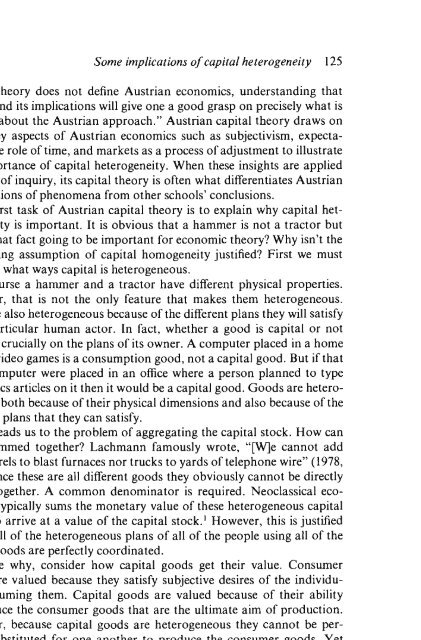Handbook on Contemporary Austrian Economics
Handbook on Contemporary Austrian Economics
Handbook on Contemporary Austrian Economics
You also want an ePaper? Increase the reach of your titles
YUMPU automatically turns print PDFs into web optimized ePapers that Google loves.
Some implicati<strong>on</strong>s of capital heterogeneity 125<br />
capital theory does not define <strong>Austrian</strong> ec<strong>on</strong>omics, understanding that<br />
theory and its implicati<strong>on</strong>s will give <strong>on</strong>e a good grasp <strong>on</strong> precisely what is<br />
distinct about the <strong>Austrian</strong> approach." <strong>Austrian</strong> capital theory draws <strong>on</strong><br />
other key aspects of <strong>Austrian</strong> ec<strong>on</strong>omics such as subjectivism, expectati<strong>on</strong>s,<br />
the role of time, and markets as a process of adjustment to illustrate<br />
the importance of capital heterogeneity. When these insights are applied<br />
to areas of inquiry, its capital theory is often what differentiates <strong>Austrian</strong><br />
explanati<strong>on</strong>s of phenomena from other schools' c<strong>on</strong>clusi<strong>on</strong>s.<br />
The first task of <strong>Austrian</strong> capital theory is to explain why capital heterogeneity<br />
is important. It is obvious that a hammer is not a tractor but<br />
why is that fact going to be important for ec<strong>on</strong>omic theory Why isn't the<br />
simplifying assumpti<strong>on</strong> of capital homogeneity justified First we must<br />
define in what ways capital is heterogeneous.<br />
Of course a hammer and a tractor have different physical properties.<br />
However, that is not the <strong>on</strong>ly feature that makes them heterogeneous.<br />
They are also heterogeneous because of the different plans they will satisfy<br />
for a particular human actor. In fact, whether a good is capital or not<br />
depends crucially <strong>on</strong> the plans of its owner. A computer placed in a home<br />
to play video games is a c<strong>on</strong>sumpti<strong>on</strong> good, not a capital good. But if that<br />
same computer were placed in an office where a pers<strong>on</strong> planned to type<br />
ec<strong>on</strong>omics articles <strong>on</strong> it then it would be a capital good. Goods are heterogeneous<br />
both because of their physical dimensi<strong>on</strong>s and also because of the<br />
different plans that they can satisfy.<br />
This leads us to the problem of aggregating the capital stock. How can<br />
it be summed together Lachmann famously wrote, "[W]e cannot add<br />
beer barrels to blast furnaces nor trucks to yards of teleph<strong>on</strong>e wire" (1978,<br />
p. 2). Since these are all different goods they obviously cannot be directly<br />
added together. A comm<strong>on</strong> denominator is required. Neoclassical ec<strong>on</strong>omics<br />
typically sums the m<strong>on</strong>etary value of these heterogeneous capital<br />
goods to arrive at a value of the capital stock. I However, this is justified<br />
<strong>on</strong>ly if all of the heterogeneous plans of all of the people using all of the<br />
capital goods are perfectly coordinated.<br />
To see why, c<strong>on</strong>sider how capital goods get their value. C<strong>on</strong>sumer<br />
goods are valued because they satisfy subjective desires of the individuals<br />
c<strong>on</strong>suming them. Capital goods are valued because of their ability<br />
to produce the c<strong>on</strong>sumer goods that are the ultimate aim of producti<strong>on</strong>.<br />
However, because capital goods are heterogeneous they cannot be perfectly<br />
substituted for <strong>on</strong>e another to produce the c<strong>on</strong>sumer goods. Yet<br />
capital goods are also multi-specific; each is capable of fitting into more<br />
than <strong>on</strong>e single producti<strong>on</strong> plan for <strong>on</strong>e c<strong>on</strong>sumer good. So capital goods<br />
derive their value from(the entrepreneurs who bid <strong>on</strong> them with the aim<br />
of incorporating those capital goods into a specific plan to produce the

















